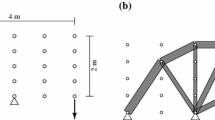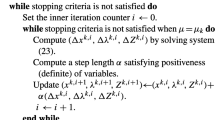Abstract
This paper considers the problem of optimal truss topology design subject to multiple loading conditions. We minimize a weighted average of the compliances subject to a volume constraint. Based on the ground structure approach, the cross-sectional areas are chosen as the design variables. While this problem is well-studied for continuous bar areas, we consider in this study the case of discrete areas. This problem is of major practical relevance if the truss must be built from pre-produced bars with given areas. As a special case, we consider the design problem for a single available bar area, i.e., a 0/1 problem. In contrast to the heuristic methods considered in many other approaches, our goal is to compute guaranteed globally optimal structures. This is done by a branch-and-bound method for which convergence can be proven. In this branch-and-bound framework, lower bounds of the optimal objective function values are calculated by treating a sequence of continuous but non-convex relaxations of the original mixed-integer problem. The main effect of using this approach lies in the fact that these relaxed problems can be equivalently reformulated as convex problems and, thus, can be solved to global optimality. In addition, these convex problems can be further relaxed to quadratic programs for which very efficient numerical solution procedures exist. By exploiting this special problem structure, much larger problem instances can be solved to global optimality compared to similar mixed-integer problems. The main intention of this paper is to provide optimal solutions for single and multiple load benchmark examples, which can be used for testing and validating other methods or heuristics for the treatment of this discrete topology design problem.
Similar content being viewed by others
References
Achtziger W (1998) Multiple load truss topology and sizing optimization: some properties of minimax compliance. J Optim Theory Appl 98:255–280
Achtziger W (1999) Local stability of trusses in the context of topology optimization, part I: exact modelling. Struct Optim 17:235–246
Achtziger W, Stolpe M (2005a) Global optimization of truss topology w.r.t. discrete bar areas—part I: theory of relaxed problems. Technical report 308, Department of Mathematics, University of Dortmund, Dortmund, Germany
Achtziger W, Stolpe M (2005b) Global optimization of truss topology w.r.t. discrete bar areas—part II: implementation and numerical results. Technical report 309, Department of Mathematics, University of Dortmund, Dortmund, Germany
Achtziger W, Stolpe M (2006) Global optimization of truss topology w.r.t. discrete bar areas—multiple loads and benchmark examples. Technical report 2006-13, Department of Mathematics, Technical University of Denmark, Lyngby, Denmark
Achtziger W, Bendsøe M, Ben-Tal A, Zowe J (1992) Equivalent displacement based formulations for maximum strength truss topology design. Impact Comput Sci Eng 4:315–345
Ben-Tal A, Bendsøe M (1993) A new method for optimal truss topology design. SIAM J Optim 3(2):322–358
Bendsøe M, Sigmund O (2003) Topology optimization—theory, methods and applications. Springer, Berlin Heidelberg New York
Bollapragada S, Ghattas O, Hooker J (2001) Optimal design of truss structures by logical-based branch and cut. Oper Res 49(1):42–51
Gill P, Murray W, Saunders M, Wright M (1991) Inertia-controlling methods for general quadratic programming. SIAM Rev 33:1–36
Gill P, Murray W, Saunders M (2002) SNOPT: an SQP algorithm for large-scale constrained optimization. SIAM J Optim 12(4):979–1006
Groenwold A, Stander N, Snyman J (1996) A pseudo-discrete rounding method for structural optimization. Struct Optim 11:218–227
Hajela P, Lee E (1995) Genetic algorithms in truss topology optimization. Int J Solids Struct 32(22):3341–3357
Horst R, Pardalos P (eds) (1995) Handbook of global optimization. Springer, Berlin Heidelberg New York
Horst R, Tuy H (1993) Global optimization: deterministic approaches. Springer, Berlin Heidelberg New York
Jarre F, Kočvara M, Zowe J (1998) Optimal truss design by interior point methods. SIAM J Optim 8(4):1084–1107
Kane C, Schoenauer M (1996) Topological optimum design using genetic algorithms. Control Cybern 25(5):1059–1087
Land A, Doig A (1960) An automatic method for solving discrete programming problems. Econometrica 28:497–520
Nemhauser G, Wolsey L (1999) Integer and combinatorial optimization. Wiley, New York
Pardalos P, Romeiin H (eds) (2002) Handbook of global optimization: vol 2. Springer, Berlin Heidelberg New York
Ringertz U (1986) A branch and bound algorithm for topology optimization of trusses. Eng Optim 10:111–124
Ringertz U (1988) On methods for discrete structural optimization. Eng Optim 13:44–64
Rozvany G (1996) Difficulties in truss topology optimization with stress, local buckling and system stability constraints. Struct Optim 11:213–217
Stolpe M, Kawamoto A (2005) Design of planar articulated mechanisms using branch and bound. Math Program 103(2):357–398
Stolpe M, Svanberg K (2003) Modeling topology optimization problems as linear mixed 0–1 programs. Int J Numer Methods Eng 57(5):723–739
Svanberg K (1998) Stress-constrained truss-type topology optimization problems that can be formulated and solved as linear or convex optimization problems. In: Cinquini C, Rovati M, Venini P, Nascimbene R (eds) Proceedings of the fifth world congress of structural and multidisciplinary optimization, Schönenfeld & Ziegler, Milano, Italy, ISBN 88-88412-27-1, paper 085
The MathWorks, Inc. (2005) Matlab user guides. http://www.mathworks.com
Author information
Authors and Affiliations
Corresponding author
Rights and permissions
About this article
Cite this article
Achtziger, W., Stolpe, M. Truss topology optimization with discrete design variables—Guaranteed global optimality and benchmark examples. Struct Multidisc Optim 34, 1–20 (2007). https://doi.org/10.1007/s00158-006-0074-2
Received:
Published:
Issue Date:
DOI: https://doi.org/10.1007/s00158-006-0074-2




